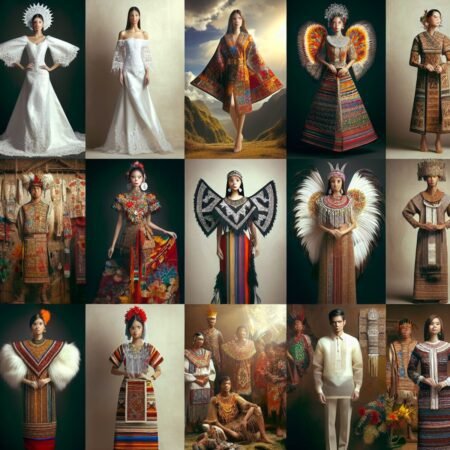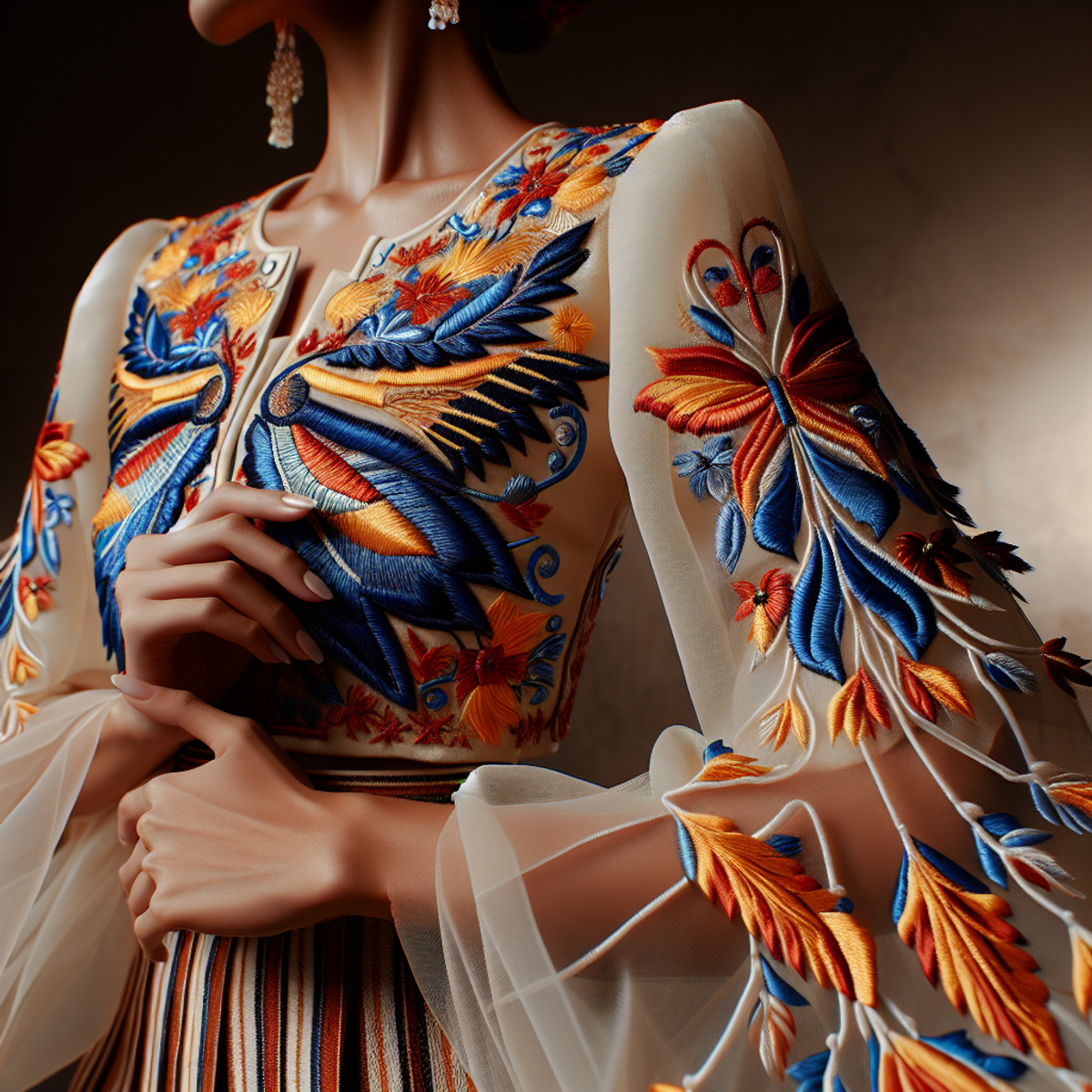
Introduction to Traditional Filipino Dress
Traditional Filipino clothing, also known as Filipino traditional dress or the Filipino national costume, is a vibrant and diverse representation of the country’s rich cultural heritage. These traditional garments not only showcase the artistic craftsmanship of Filipino artisans but also serve as a way to connect with one’s roots and preserve the country’s identity in a globalized world.
In the Philippines, each region has its own unique style of traditional attire, influenced by its history and various cultural influences. From the colorful and intricately embroidered Baro’t Saya to the elegant Barong Tagalog, these garments reflect the fusion of indigenous traditions with influences from Chinese, Spanish, American, and other cultures.
The different regions in the Philippines boast distinct styles of traditional dress that are deeply rooted in their local histories and indigenous heritage.
1. Baro’t Saya: The Exquisite Women’s Ensemble
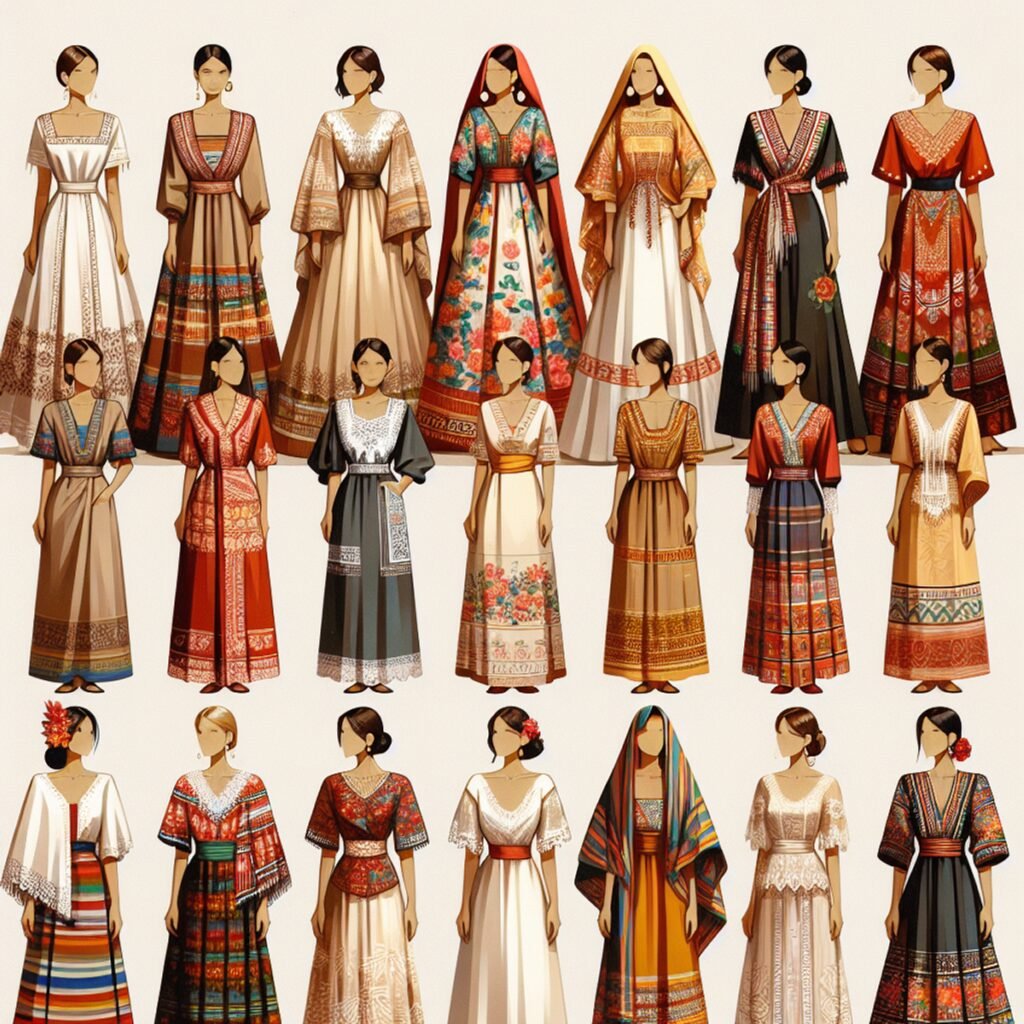
The Baro’t Saya is a traditional Filipino outfit that represents the beauty and poise of Filipino women. It consists of two main pieces: the “Kimona” blouse and the “Saya” skirt.
The Kimona: A Loose-Fitting Top with Butterfly Sleeves
The Kimona is a loose-fitting top made from lightweight fabric like piña, jusi, or organza. It has intricate embroidery on the neckline and sleeves, showcasing the skill of Filipino artisans. One of its distinctive features is the butterfly sleeves, also known as “Camisa de Chino,” which resemble butterfly wings and add a feminine touch to the ensemble.
The Saya: A Floor-Length Skirt for Graceful Movement
The Saya is a long skirt that comes in different styles and designs. It can be made from colorful woven fabric like Inabel or decorated with delicate lacework. The Saya is worn high on the waist, creating an elegant silhouette for the wearer.
Additional Accessories to Enhance the Look
To complete the Baro’t Saya outfit, women often wear additional accessories:
- Tapis: A wide embroidered wraparound skirt worn over the Saya, adding layers and texture to the ensemble.
- Panuelo: A decorative scarf worn around the neck or draped over one shoulder, enhancing the overall elegance.
Evolution of Baro’t Saya: From Spanish Influence to Modern Interpretations
The Baro’t Saya has changed over time, reflecting shifts in fashion and cultural influences. Although it originated during Spanish colonial rule, it has incorporated indigenous elements and contemporary designs. Today, we can see updated versions of the Baro’t Saya on fashion runways and red carpets, demonstrating its timeless charm.
Cultural Significance: More Than Just Clothing
Beyond its aesthetic appeal, the Baro’t Saya holds deep cultural significance:
- It is a symbol of Filipino heritage and identity, representing our diverse traditions.
- Wearing the Baro’t Saya is a way for Filipino women to honor their ancestors’ resilience and creativity.
- By embracing this traditional attire, we contribute to the preservation of our cultural heritage.
The Baro’t Saya serves as a reminder of the beauty and strength rooted in our past, present, and future.
2. Barong Tagalog: The Timeless Men’s Attire
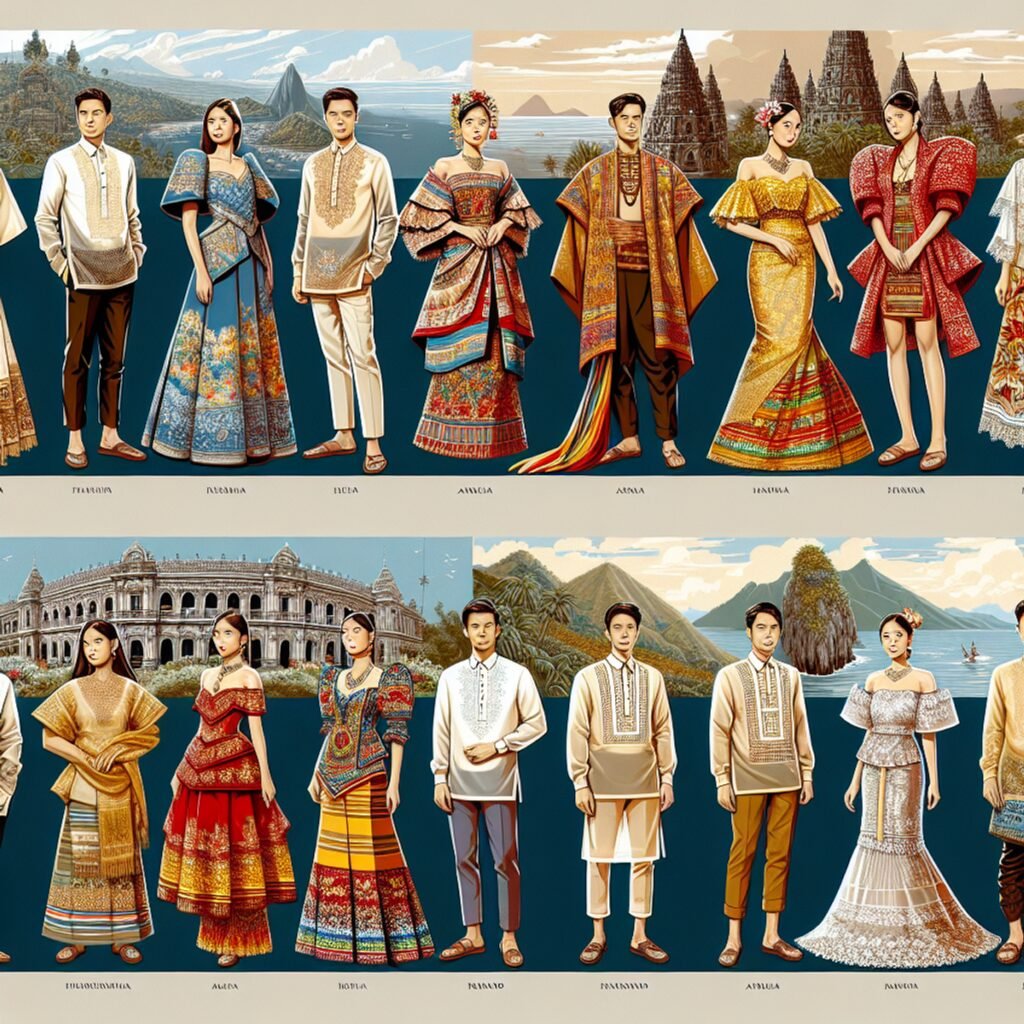
The Barong Tagalog is an important part of Filipino culture and is considered the national attire for men. It represents both elegance and tradition, which is why it remains a popular choice for formal events and special occasions. The sheer fabric of the Barong Tagalog is adorned with intricate embroidery, showcasing the artistic heritage of the Philippines.
Key Points:
- The Barong Tagalog is deeply rooted in Filipino tradition and is often worn during weddings, cultural celebrations, and formal gatherings.
- Different types of fabrics are used to create the Barong Tagalog, with Piña (pineapple fiber) and Organza being popular choices due to their delicate texture and luxurious appeal.
- Wearing the Barong Tagalog is an art in itself. It is typically paired with dress pants and polished leather shoes, exuding a sense of style and sophistication.
The Barong Tagalog represents the blending of native craftsmanship and Spanish influence, serving as a symbol of Filipino identity and fashion excellence.
3. Intricate Weaves: A Showcase of Filipino Textile Artistry
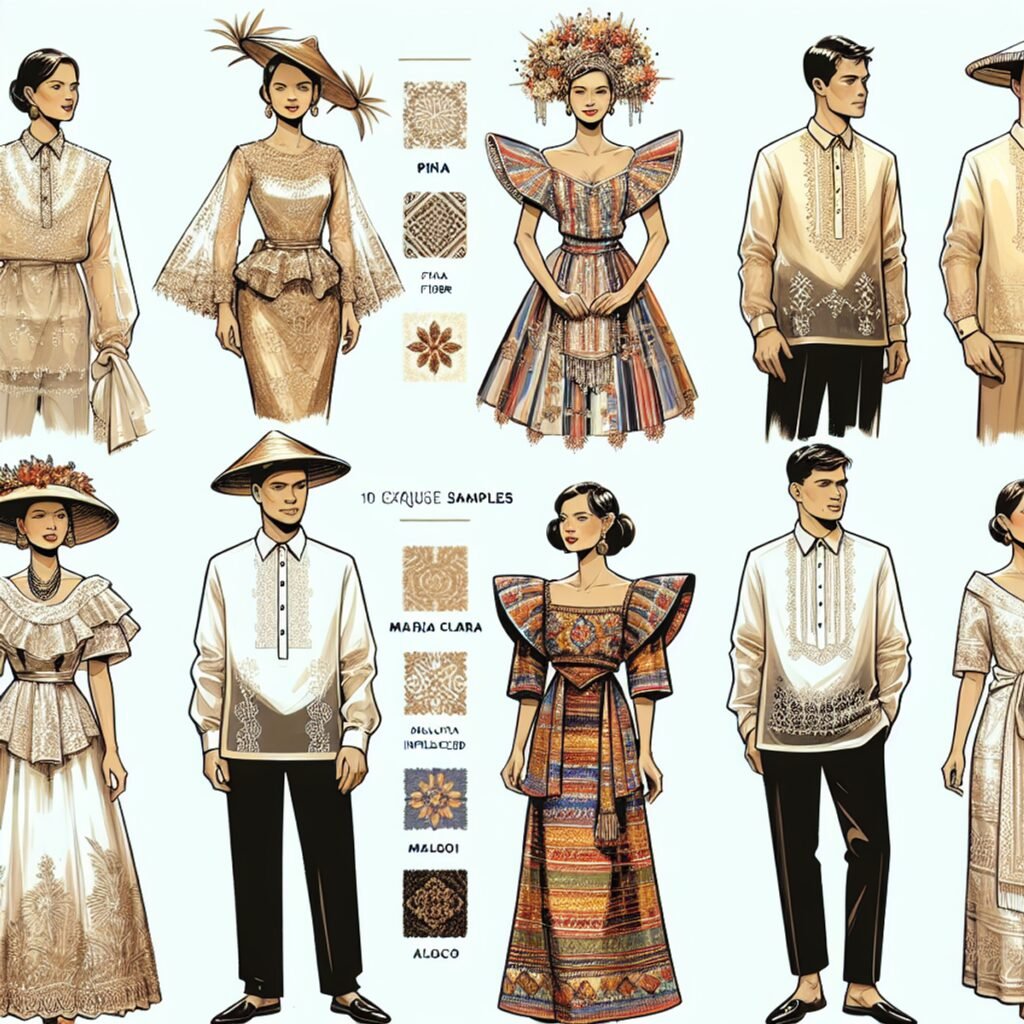
The weaving traditions in the Philippines are rich and diverse, showcasing the artistry and skill of Filipino textile makers. Indigenous fabrics such as Inabel, Yakan, and T’nalak are notable for their intricate designs and cultural significance. These traditional Filipino textiles represent the heritage and craftsmanship of various indigenous communities across the country.
Overview of Weaving Traditions
The Philippines boasts a wide array of weaving techniques, each unique to specific regions and ethnic groups. From the detailed patterns of the Abel Iloko to the vibrant hues of Yakan weaves, these traditions tell stories of heritage and identity.
Highlighting Indigenous Fabrics
- Inabel: Originating from the Ilocos region, Inabel features geometric patterns and bold colors, reflecting the artistry of the Ilocano weavers.
- Yakan Fabric: Known for its bright and intricate tapestry weave, often used in crafting traditional attire.
- T’nalak: A sacred cloth among the T’boli people, showcasing intricate dream-inspired designs created through a complex process of abaca fiber preparation and dyeing.
These indigenous fabrics not only embody the creativity of Filipino weavers but also serve as tangible expressions of cultural pride and tradition.
4. Accessorizing in Filipino Fashion: From Tapis to Bahag
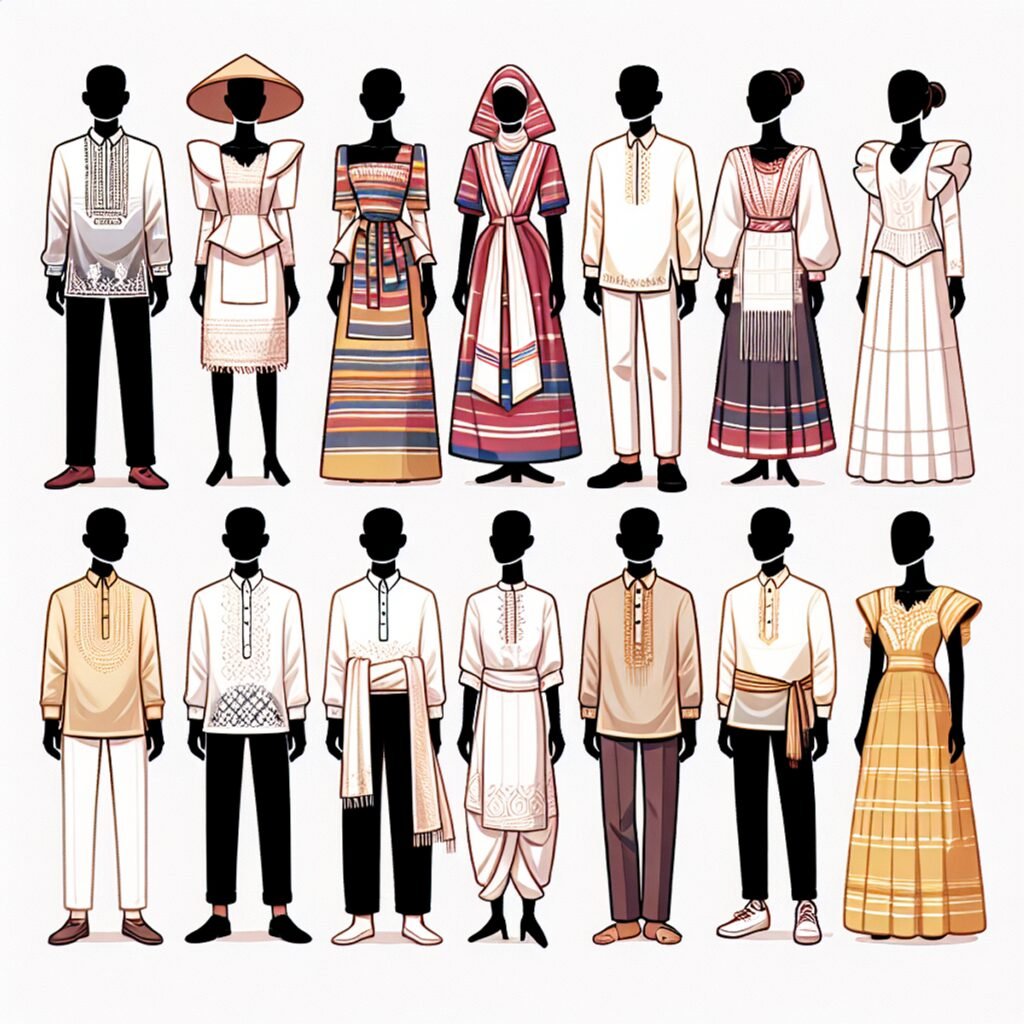
Accessories play a crucial role in enhancing traditional Filipino attire. They add intricate details and cultural significance to the overall look. Here are some key points to consider:
Significance of Tapis and Panuelo
Tapis, a wraparound skirt worn by women, complements the Baro’t Saya ensemble. On the other hand, Panuelo, a scarf or shawl, is traditionally worn with the Barong Tagalog. Both accessories add elegance and flair to the attire.
Unique Accessories
The Kegal T’boli belt stands out as a striking accessory that adds vibrancy to traditional T’boli clothing with its colorful beadwork. Another notable accessory is the Bahag loincloth, commonly worn by indigenous men, which showcases the artistry and cultural heritage of Filipino fashion.
These accessories not only contribute to the visual appeal of traditional Filipino clothing but also serve as symbols of cultural identity and heritage.
Regional Styles in Philippine Traditional Attire
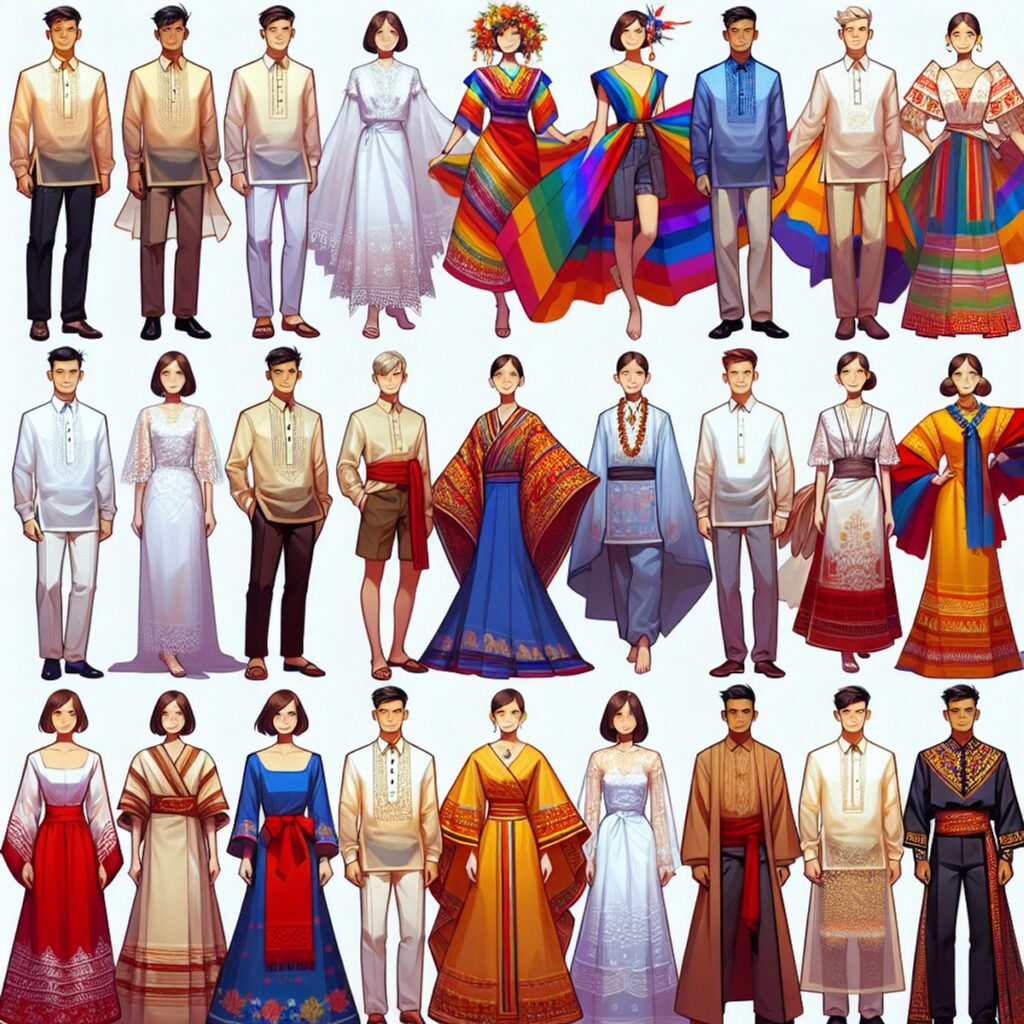
Traditional Filipino attire varies significantly across different regions and ethnic groups in the Philippines. Each region has its own distinctive style and characteristics that reflect the cultural heritage and history of the local communities. Here are some examples of traditional garments from major ethnic groups:
Moro Traditional Clothing
The Moro people in Mindanao have a rich tradition of clothing, which includes the Malong, a tubular piece of fabric wrapped around the body, often used as a skirt or dress. The Patadyong is another traditional garment worn by Moro women, characterized by its vibrant colors and intricate designs.
Mangyan Attire
The Mangyan people in Mindoro are known for their unique traditional clothing. Men wear a loincloth called “bahag,” while women wear wraparound skirts made from handwoven fabrics.
Igorot Textiles
The Igorot tribes in the Cordillera region are famous for their intricate textiles. Women traditionally wear wraparound skirts made from woven fabrics adorned with geometric patterns and bright colors.
These examples highlight the diversity and beauty of traditional Filipino attire, showcasing the creativity and craftsmanship of different regions in the Philippines. Each garment tells a story and represents a distinct cultural identity within the country.
By exploring regional styles in Philippine traditional attire, we gain a deeper understanding of the rich cultural heritage and diversity that exists within the Philippines.
Revitalizing Traditional Dress through Contemporary Fashion
Modern interpretations of Filipino clothing have gained traction in the fashion world, breathing new life into traditional attire. Designers and fashion enthusiasts alike have embraced the challenge of infusing classic elements of Filipino dress with a modern twist, resulting in stunning creations that pay homage to the country’s rich cultural heritage.
1. Adaptation of traditional elements in modern Filipino fashion trends
Designers have skillfully incorporated indigenous fabrics, intricate embroidery, and timeless silhouettes into contemporary clothing pieces, offering a fresh take on traditional Filipino attire. This transformation is evident in the works of designers like Tracy Dizon, who seamlessly blend traditional elements with modern aesthetics.
2. Celebrity red carpet moments showcasing Filipino-inspired couture gowns and suits
Renowned personalities have graced high-profile events donning exquisite Filipiniana-inspired ensembles, showcasing the elegance and allure of traditional Filipino clothing on an international stage. These iconic fashion moments have effectively propelled the global visibility of Filipino fashion, garnering admiration and appreciation worldwide.
The Significance of Preserving Our Cultural Identity Through Clothing
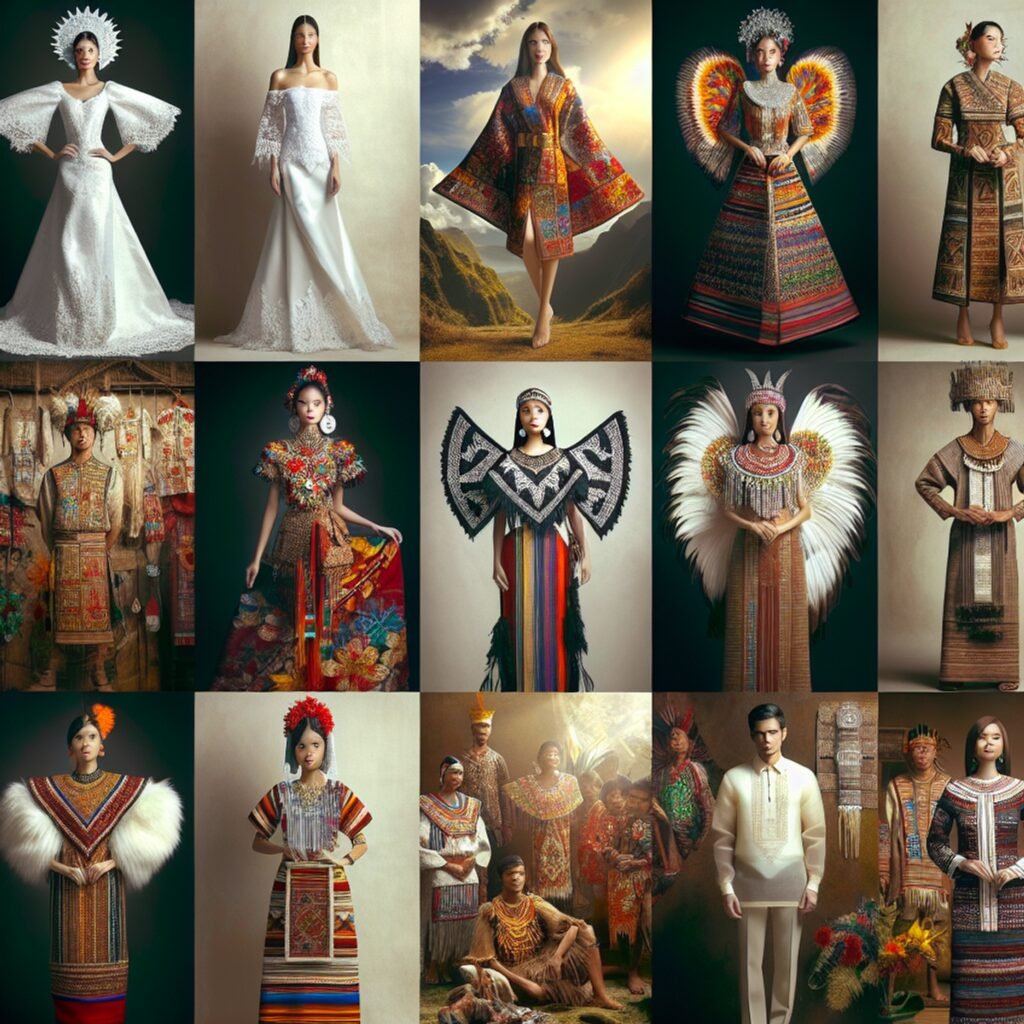
Valuing and wearing traditional clothing is a powerful way to connect with our roots and preserve our Filipino identity in today’s globalized world. Traditional dress holds immense cultural value and serves as a tangible link to our rich heritage. By embracing and promoting these traditional garments, we can keep our cultural identity alive and thriving.
Here are some key points highlighting the significance of preserving our cultural identity through clothing:
1. Preserving Cultural Heritage
Traditional Filipino clothing represents centuries of history, traditions, and craftsmanship. Each garment tells a story, reflecting the diverse influences that have shaped Filipino culture over time. By cherishing and wearing these garments, we honor the skills and artistry of our ancestors.
2. Connecting with Our Roots
Traditional dress allows us to forge a deep connection with our cultural roots. It serves as a visual representation of our heritage, reminding us of our ancestors’ struggles, triumphs, and unique way of life. Wearing traditional clothing can evoke a sense of pride, belonging, and nostalgia.
3. Celebrating Diversity
The Philippines is a nation of diverse ethnic groups and regions, each with its distinct traditional attire. By embracing these regional styles and wearing them proudly, we celebrate the richness and diversity of Filipino culture. It is a way to acknowledge and appreciate the contributions of different communities to our collective identity.
4. Promoting Cultural Exchange
When we wear traditional Filipino clothing, we not only showcase our own culture but also invite others to learn about it. It sparks curiosity and opens doors for cross-cultural conversations. By sharing the stories behind our traditional garments, we foster understanding, respect, and appreciation for Filipino culture on a global scale.
Preserving our cultural identity through clothing is not just an act of fashion; it is a statement of pride, resilience, and love for our heritage. By continuing to wear traditional Filipino attire in our daily lives, special occasions, and cultural events, we ensure that these beautiful garments remain an integral part of our cultural fabric for generations to come.
Where to Experience the Beauty of Filipino Traditional Fashion
If you’re eager to immerse yourself in the captivating world of Filipino traditional fashion, there are several places in the Philippines where you can witness the beauty and artistry of these garments up close. Here are some recommendations for museums, festivals, and cultural centers that showcase stunning displays of traditional Filipino attire:
- National Museum of Anthropology, Manila: Located within the National Museum complex in Manila, this museum houses an extensive collection of indigenous textiles and traditional clothing from various regions in the Philippines. Visitors can explore exhibits that highlight the craftsmanship and cultural significance of these garments.
- Hibla ng Lahing Filipino Textile Gallery, Taguig City: This gallery is dedicated to promoting and preserving Philippine textiles. It features a wide array of traditional garments, including intricately woven fabrics and beautifully embroidered pieces.
- T’nalak Festival, South Cotabato: Celebrated annually in July, this festival showcases the vibrant culture of the T’boli tribe in Mindanao. Visitors can witness the T’boli people wearing their traditional clothing adorned with intricate beadwork and participate in cultural activities that celebrate their rich textile heritage.
- Pahiyas Festival, Lucban, Quezon: Held every May, this colorful festival pays tribute to San Isidro Labrador, the patron saint of farmers. The locals decorate their houses with colorful rice wafers and adorn themselves in traditional attire, showcasing the unique clothing styles of the region.
- Kadayawan Festival, Davao City: Celebrated in August each year, this festival brings together various indigenous groups from Mindanao. Visitors can witness spectacular street parades featuring traditional costumes adorned with vibrant colors and elaborate beadwork.
These are just a few examples of places where you can experience the beauty of Filipino traditional fashion. Exploring these locations will not only allow you to appreciate the exquisite craftsmanship of these garments, but also provide a deeper understanding of the cultural significance they hold in Philippine society.
How to Incorporate Filipino Elements into Your Everyday Style
Here are some practical tips on how you can add Filipino elements to your outfits in a subtle and fashionable way, showing respect for the culture:
1. Choose Clothing Made from Traditional Fabrics
Look for clothing items made from traditional Filipino textiles such as Piña, Abel Iloco, or T’nalak. You can incorporate these fabrics into your daily outfits through shirts, blouses, skirts, or even accessories like scarves or bags.
2. Look for Delicate Embroidery
Seek out pieces with delicate Filipino-inspired embroidery. This could be small details on a collar, cuffs, or hemlines that pay homage to the intricate embroidery found in traditional Filipino attire.
3. Embrace Filipino Accessories
Embrace Filipino culture through accessories like statement jewelry made by local artisans, or by incorporating traditional patterns into your accessory choices.
4. Integrate Colors and Patterns
Integrate traditional Filipino colors and patterns into your wardrobe. Look for pieces with vibrant colors and bold patterns that reflect the rich heritage of Filipino design.
5. Blend Traditional and Modern Pieces
Experiment with blending traditional Filipino elements with modern fashion. Mix and match traditional pieces with contemporary clothing for a unique and personalized style that respects and celebrates Filipino culture.
By following these tips, you can incorporate Filipino elements into your everyday style in a way that is respectful and appreciative of the culture’s beauty.
Conclusion
Traditional Filipino dress is not just a fashion statement but a reflection of the rich cultural heritage and diversity of the Philippines. Embracing and celebrating the beauty of Filipino cultural attire is a way to connect with our roots, preserve our identity, and show cultural pride and appreciation. By wearing traditional clothing, we honor the craftsmanship and artistry of local artisans and weavers who dedicate their skills to keeping these traditions alive.
To support local artisans and weavers who create stunning Filipino cultural outfits, consider the following suggestions:
- Buy from local markets and artisans: Look for traditional garments made by local artisans in markets or through online platforms that directly support their livelihoods.
- Attend cultural festivals: Attend festivals or cultural events that showcase traditional Filipino dress. These events often have booths where you can purchase authentic garments or accessories.
- Visit museums: Explore museums with exhibits on Filipino traditional clothing. Not only will you gain knowledge about the history and significance of these garments, but you may also find inspiration for your own style.
- Collaborate with local designers: Seek out collaborations with local fashion designers who incorporate Filipino elements into their designs. This supports both traditional craftsmanship and contemporary fashion.
Remember, when incorporating Filipino elements into your everyday style, it is essential to do so respectfully and without appropriating or disrespecting the culture. By embracing traditional Filipino dress in an informed and respectful manner, we can contribute to the preservation and continuation of these beautiful traditions for generations to come.
So why not add a touch of elegance and cultural flair to your wardrobe by exploring the stunning examples of traditional Filipino dress? Let the vibrant colors, intricate embroidery, and exquisite craftsmanship inspire you to celebrate the beauty of Filipino cultural attire.
Embrace tradition, preserve heritage.
FAQs (Frequently Asked Questions)
What is the significance of traditional Filipino clothing in the culture?
Traditional Filipino clothing holds great importance in the culture as it reflects the rich heritage and traditions of the Filipino people. It serves as a symbol of identity and pride, connecting individuals to their roots and history.
How do traditional attire vary across different regions in the Philippines?
The traditional attire in the Philippines varies across different regions due to historical influences and cultural diversity. Each region showcases unique styles, fabrics, and designs that are influenced by their respective histories and indigenous practices.
What are the key elements of a complete Baro’t Saya outfit?
A complete Baro’t Saya outfit includes the Baro (blouse) and Saya (skirt) for women. The ensemble also features intricate details such as the Kimona (top) with Butterfly sleeves, which are iconic elements of this traditional Filipino clothing.
What are the different types of fabrics used in creating a Barong Tagalog?
The Barong Tagalog is crafted using various types of fabrics, including Piña (pineapple fiber), Organza, and Jusi. These delicate fabrics contribute to the elegance and timelessness of the men’s traditional attire in the Philippines.
How can individuals incorporate Filipino elements into their everyday style?
To incorporate Filipino elements into everyday style, individuals can opt for modern interpretations of Filipino clothing or accessories inspired by traditional designs. This can be done in a subtle and respectful manner, showing appreciation for Filipino culture without appropriating it.
Where can visitors admire stunning displays of traditional Filipino attire?
Visitors interested in admiring traditional Filipino attire can explore museums, festivals, and cultural centers throughout the Philippines. These venues often showcase exquisite displays that highlight the beauty and diversity of Filipino traditional fashion.
